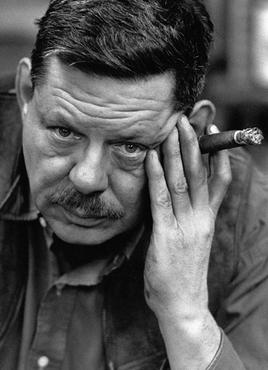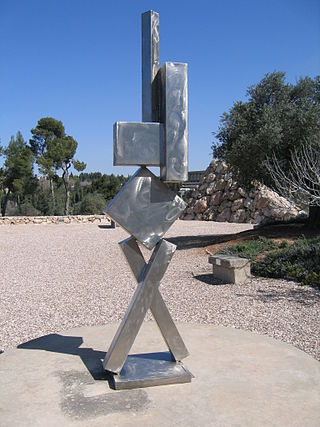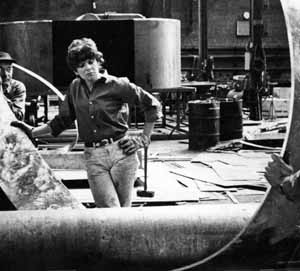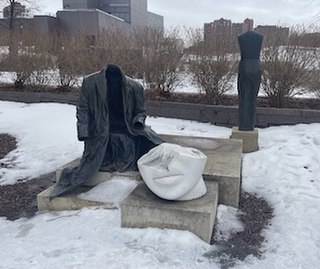
The National Gallery of Art, and its attached Sculpture Garden, is a national art museum in Washington, D.C., United States, located on the National Mall, between 3rd and 9th Streets, at Constitution Avenue NW. Open to the public and free of charge, the museum was privately established in 1937 for the American people by a joint resolution of the United States Congress. Andrew W. Mellon donated a substantial art collection and funds for construction. The core collection includes major works of art donated by Paul Mellon, Ailsa Mellon Bruce, Lessing J. Rosenwald, Samuel Henry Kress, Rush Harrison Kress, Peter Arrell Browne Widener, Joseph E. Widener, and Chester Dale. The Gallery's collection of paintings, drawings, prints, photographs, sculpture, medals, and decorative arts traces the development of Western art from the Middle Ages to the present, including the only painting by Leonardo da Vinci in the Americas and the largest mobile created by Alexander Calder.

The Hirshhorn Museum and Sculpture Garden is an art museum beside the National Mall in Washington, D.C., United States. The museum was initially endowed during the 1960s with the permanent art collection of Joseph H. Hirshhorn. It was designed by architect Gordon Bunshaft and is part of the Smithsonian Institution. It was conceived as the United States' museum of contemporary and modern art and currently focuses its collection-building and exhibition-planning mainly on the post–World War II period, with particular emphasis on art made during the last 50 years.

Anne Truitt, born Anne Dean, was an American sculptor of the mid-20th century.

Roland David Smith was an influential and innovative American abstract expressionist sculptor and painter, best known for creating large steel abstract geometric sculptures. Born in Decatur, Indiana, Smith initially pursued painting, receiving training at the Art Students League in New York from 1926 to 1930. However, his artistic journey took a transformative turn in the early 1930s when he shifted his focus to sculpture.

Robert Gober is an American sculptor. His work is often related to domestic and familiar objects such as sinks, doors, and legs.

Sam Gilliam was an American color field painter and lyrical abstractionist artist. Gilliam was associated with the Washington Color School, a group of Washington, D.C.-area artists that developed a form of abstract art from color field painting in the 1950s and 1960s. His works have also been described as belonging to abstract expressionism and lyrical abstraction. He worked on stretched, draped and wrapped canvas, and added sculptural 3D elements. He was recognized as the first artist to introduce the idea of a draped, painted canvas hanging without stretcher bars around 1965. This was a major contribution to the Color Field School and has had a lasting impact on the contemporary art canon. Arne Glimcher, Gilliam's art dealer at Pace Gallery, wrote following his death that "His experiments with color and surface are right up there with the achievements of Rothko and Pollock."

Alma Woodsey Thomas was an African-American artist and teacher who lived and worked in Washington, D.C., and is now recognized as a major American painter of the 20th century. Thomas is best known for the "exuberant", colorful, abstract paintings that she created after her retirement from a 35-year career teaching art at Washington's Shaw Junior High School.

The Cubi series is a group of stainless steel sculptures built from cubes, rectangular solids and cylinders with spheroidal or flat endcaps. These pieces are among the last works completed by the sculptor David Smith. The artist died in a car accident on May 23, 1965, soon after the completion of Cubi XXVIII, which may or may not have been the last sculpture he intended to create in this series. The Cubis are among Smith's final experiments in his progression toward a more simplified, abstract form of expression. As an example of Modernism, these are representative of the monumental works in industrial materials that characterized much of the sculpture from this period.
Rachel Harrison is an American visual artist known for her sculpture, photography, and drawing. Her work often combines handmade forms with found objects or photographs, bringing art history, politics, and pop culture into dialogue with one another. She has been included in numerous exhibitions in Europe and the US, including the Venice Biennale, the Whitney Biennial and the Tate Triennial (2009). Her work is in the collections of major museums such as The Museum of Modern Art, New York; Metropolitan Museum of Art, New York; Hirshhorn Museum and Sculpture Garden, Washington, D.C.; and Tate Modern, London; among others. She lives and works in New York.

Beverly Pepper was an American sculptor known for her monumental works, site specific and land art. She remained independent from any particular art movement. She lived in Italy, primarily in Todi, since the 1950s.

Grant Mudford, is an Australian photographer.

Judith Shea is an American sculptor and artist, born in Philadelphia, Pennsylvania, in 1948. She received a degree in fashion design at Parsons School of Design in 1969 and a BFA in 1975. This dual education formed the basis for her figure based works. Her career has three distinct phases: The use of cloth and clothing forms from 1974 to 1981; Hollow cast metal clothing-figure forms from 1982 until 1991; and carved full-figure statues made of wood, cloth, clay, foam and hair beginning in 1990 to present.
Melissa Chiu is an Australian museum director, curator and author, and the director of the Hirshhorn Museum and Sculpture Garden in Washington, DC.

Throwback is a public artwork by American artist Tony Smith, located at the Hirshhorn Museum and Sculpture Garden in Washington, D.C., United States. This version is the third of an edition of three in the series with one artist's proof.

Are Years What? is a sculpture by American artist Mark di Suvero. It is in the collection of the Hirshhorn Museum and Sculpture Garden, in Washington, D.C., United States. The sculpture is named after poet Marianne Moore's "What Are Years". From May 22, 2013 through May 26, 2014, the sculpture resided temporarily in San Francisco, as part of the San Francisco Museum of Modern Art's Mark di Suvero exhibition at Crissy Field.

Linn Meyers is an American, Washington, D.C.–based artist. Her work has been exhibited in the United States and abroad. She is known for her hand-drawn lines and tracings for site-specific installations.

Houston Eugene Conwill was an American multidisciplinary artist known best for large-scale public sculptural installations. Conwill was a sculptor, painter, and performance and conceptual artist whose site-specific works explore and celebrate spirituality and African-American artists, activists, and intellectuals. Studio Museum in Harlem recognised his body of work as a "lasting monument to black culture."
Maggie Michael is an American painter. Born in Milwaukee, Michael has spent much of her career in Washington, D.C. A 1996 graduate of the University of Wisconsin-Milwaukee, from which she received a BFA, with honors, she received her MA from San Francisco State University in 2000 and her MFA from American University in 2002. She has received numerous awards during her career, including a grant from the Joan Mitchell Foundation in 2004, the same year in which she was given a Young Artist Grant by the D.C. Commission on the Arts and Humanities; she has also worked with the Hirshhorn Museum and Sculpture Garden. Michael is married to the sculptor Dan Steinhilber. She has served on the faculty of the Corcoran College of Art and Design.















